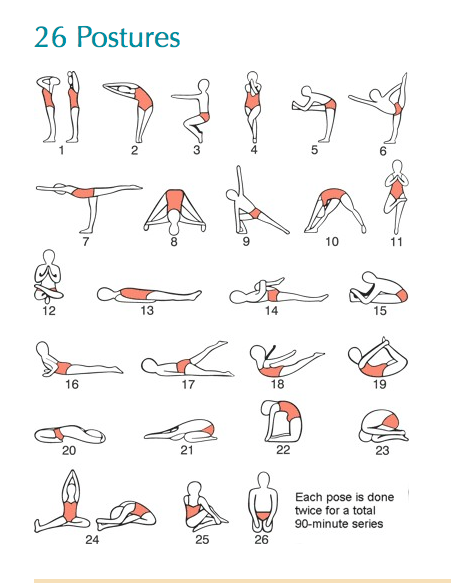
What Is The Difference Between Hot Yoga And Bikram Yoga?
As yoga continues to gain popularity, new variations and styles are emerging. Hot yoga and Bikram yoga are two such variations that have gained a lot of attention in recent years. While both of these types of yoga involve practicing in a heated room, there are some key differences between them.
Hot yoga is a general term used to describe any yoga practice that is done in a heated room. The temperature of the room is typically between 90 and 105 degrees Fahrenheit, and the humidity is usually around 40%. The heat is meant to help loosen muscles and increase flexibility, and it also adds an element of intensity to the practice. Bikram yoga, on the other hand, is a specific form of hot yoga that consists of a set sequence of 26 postures and two breathing exercises. The room is heated to a specific temperature of 105 degrees Fahrenheit with 40% humidity. Understanding the difference between these two types of yoga can help you decide which one is right for you based on your personal goals and preferences.
Hot yoga is a general term for yoga practices performed in a heated room. Bikram yoga is a specific type of hot yoga that involves a set sequence of 26 postures and two breathing exercises, performed in a room heated to 105°F with 40% humidity. The main difference between hot yoga and Bikram yoga is that while all Bikram yoga is hot yoga, not all hot yoga is Bikram yoga.

Hot Yoga vs. Bikram Yoga: What’s the Difference?
1. Origin and History
Hot yoga and Bikram yoga are two popular forms of yoga that are often confused with each other. While hot yoga is a generic term for any yoga practice done in a heated room, Bikram yoga is a specific style of yoga created by Bikram Choudhury in the 1970s. Bikram yoga consists of a set sequence of 26 postures and two breathing exercises, all performed in a room heated to 105 degrees Fahrenheit with 40% humidity.
Hot yoga, on the other hand, can refer to any style of yoga that is practiced in a heated room, regardless of the sequence or the temperature. Hot yoga classes can vary widely in terms of temperature, humidity, and style.
2. Temperature and Humidity
The main difference between hot yoga and Bikram yoga is the temperature and humidity of the room. Bikram yoga is always practiced in a room heated to 105 degrees Fahrenheit with 40% humidity. Hot yoga classes, on the other hand, can range from 85 to 105 degrees Fahrenheit with varying levels of humidity.
The higher temperature and humidity in Bikram yoga is said to help loosen the muscles and increase flexibility, while also promoting detoxification and weight loss. However, the extreme heat can also be dangerous for some people, particularly those with heart conditions or high blood pressure.
3. Sequence and Postures
Another key difference between hot yoga and Bikram yoga is the sequence and postures. Bikram yoga consists of a set sequence of 26 postures and two breathing exercises, all performed in the same order. The postures are designed to work every part of the body, from the muscles to the organs to the glands.
Hot yoga classes, on the other hand, can vary widely in terms of the sequence and postures. Some hot yoga classes may follow a specific sequence, while others may be more free-form. The postures can also vary depending on the teacher and the style of yoga being practiced.
4. Benefits of Hot Yoga
Hot yoga has been touted for its many health benefits, including increased flexibility, improved circulation, and reduced stress. The heat and humidity can also promote detoxification and weight loss, as the body sweats out toxins and burns calories.
Hot yoga can also be a great way to build strength and endurance, as the muscles are forced to work harder in the heat. And because hot yoga classes can vary widely in terms of style and sequence, there is something for everyone, from beginners to advanced practitioners.
5. Benefits of Bikram Yoga
Like hot yoga, Bikram yoga has many health benefits, including increased flexibility, improved circulation, and reduced stress. The set sequence of postures is designed to work every part of the body, from the muscles to the organs to the glands, and the heat and humidity can help promote detoxification and weight loss.
In addition, the specific sequence of postures in Bikram yoga can help improve balance, coordination, and concentration. And because the sequence is always the same, practitioners can track their progress and see improvements over time.
6. Risks of Hot Yoga
While hot yoga can be a great way to improve flexibility, build strength, and reduce stress, it is not without its risks. The extreme heat and humidity can be dangerous for some people, particularly those with heart conditions or high blood pressure.
In addition, the heat can cause dehydration and heat exhaustion if proper precautions are not taken. It is important to stay hydrated, take breaks as needed, and listen to your body during hot yoga classes.
7. Risks of Bikram Yoga
Like hot yoga, Bikram yoga can also be risky for some people. The extreme heat and humidity can be dangerous for those with heart conditions or high blood pressure, and the set sequence of postures may not be appropriate for everyone.
In addition, the heat and humidity can cause dehydration and heat exhaustion if proper precautions are not taken. It is important to stay hydrated, take breaks as needed, and listen to your body during Bikram yoga classes.
8. Hot Yoga vs. Bikram Yoga
So which is better, hot yoga or Bikram yoga? The answer is, it depends. Both types of yoga have their benefits and their risks, and the best choice depends on your individual needs and preferences.
If you are looking for a more structured, predictable yoga practice with a set sequence of postures, Bikram yoga may be the way to go. If you prefer a more varied, free-form practice with a wider range of postures and styles, hot yoga may be a better fit.
9. Hot Yoga vs. Bikram Yoga: Pros and Cons
| Hot Yoga | Bikram Yoga | |
|---|---|---|
| Pros | Varied styles and sequences, more accessible to beginners, can be less intense | Structured sequence, can improve balance and concentration, predictable |
| Cons | Risk of injury, not suitable for everyone, can be expensive | Extreme heat and humidity, risk of injury, not suitable for everyone |
10. Conclusion
In conclusion, hot yoga and Bikram yoga are two popular forms of yoga that are often confused with each other. While hot yoga is a generic term for any yoga practice done in a heated room, Bikram yoga is a specific style of yoga with a set sequence of postures and two breathing exercises, all performed in a room heated to 105 degrees Fahrenheit with 40% humidity.
Both types of yoga have their benefits and their risks, and the best choice depends on your individual needs and preferences. Be sure to take proper precautions, stay hydrated, and listen to your body during hot yoga and Bikram yoga classes to avoid injury and get the most out of your practice.
Frequently Asked Questions
Yoga is a great way to stay fit and healthy, and there are many different types of yoga to choose from. Two popular types of yoga are hot yoga and Bikram yoga. While they may seem similar, there are some key differences between the two. Here are some frequently asked questions about the difference between hot yoga and Bikram yoga.
What is hot yoga?
Hot yoga is a type of yoga that is practiced in a heated room. The temperature of the room can vary, but it is usually between 80 and 100 degrees Fahrenheit. The heat is meant to help you sweat more and loosen up your muscles, which can make it easier to do the yoga poses. There are many different types of hot yoga, including vinyasa, power yoga, and hot flow.
Hot yoga can be a great way to challenge yourself and improve your flexibility and strength. However, it is important to stay hydrated during hot yoga classes, and to listen to your body if you start to feel dizzy or nauseous.
What is Bikram yoga?
Bikram yoga is a specific type of hot yoga that was developed by Bikram Choudhury in the 1970s. It consists of a series of 26 poses that are performed in a room that is heated to 105 degrees Fahrenheit with 40% humidity. Each class is 90 minutes long, and the same series of poses is done in the same order every time.
Bikram yoga can be a great way to improve your flexibility, strength, and balance. However, it is important to be aware of the risks of practicing Bikram yoga in a heated room. The high temperature and humidity can put a lot of stress on your body, so it is important to stay hydrated and listen to your body during class.
What are the benefits of hot yoga?
Hot yoga can have many benefits for your body and mind. The heat can help to increase your flexibility and range of motion, and can also help you to sweat out toxins and impurities from your body. Hot yoga can also be a great way to relieve stress and improve your mental health.
However, it is important to be aware of the risks of practicing hot yoga. The heat can put a lot of stress on your body, and can increase your risk of dehydration and heat exhaustion. It is important to stay hydrated and to listen to your body during hot yoga classes.
What are the benefits of Bikram yoga?
Bikram yoga can have many of the same benefits as hot yoga, including increased flexibility and strength, as well as stress relief and improved mental health. In addition, because Bikram yoga consists of a specific series of poses that are done in the same order every time, it can be a great way to track your progress and see how your body is improving over time.
However, as with any type of hot yoga, it is important to be aware of the risks and to listen to your body during class. Bikram yoga can be very challenging, and the high temperature and humidity can put a lot of stress on your body. It is important to stay hydrated and to take breaks if you start to feel dizzy or nauseous.
Which type of yoga is right for me?
The type of yoga that is right for you will depend on your goals and preferences. If you are looking for a challenging workout that will help you to sweat out toxins and impurities, hot yoga may be a good choice. If you are looking for a more structured practice that focuses on a specific series of poses, Bikram yoga may be a good choice. However, it is important to be aware of the risks of practicing hot yoga or Bikram yoga in a heated room, and to listen to your body during class.
The Dangers of Bikram Yoga | Bikram vs. Other Styles of Yoga
In summary, while both hot yoga and Bikram yoga involve practicing yoga in a heated room, there are significant differences between the two practices. Hot yoga refers to a broader category of yoga styles performed in a heated environment, while Bikram yoga is a specific type of hot yoga that follows a specific sequence of 26 postures and two breathing exercises. Bikram yoga is also trademarked and only taught by certified teachers.
Ultimately, the choice between hot yoga and Bikram yoga will depend on your personal preferences and goals. If you’re looking for a more traditional yoga experience with a set sequence and certified teachers, Bikram yoga may be the right choice for you. However, if you prefer a more varied practice with a wider range of styles and teachers, hot yoga may be a better fit. Whatever you choose, both hot yoga and Bikram yoga offer a challenging and rewarding practice that can help improve your physical and mental well-being.

